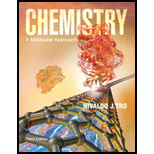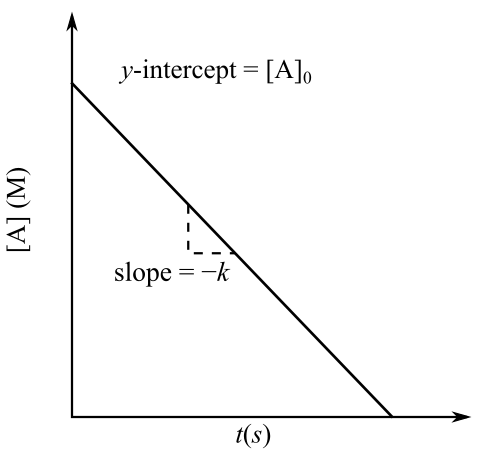
Chemistry: A Molecular Approach
3rd Edition
ISBN: 9780321809247
Author: Nivaldo J. Tro
Publisher: Prentice Hall
expand_more
expand_more
format_list_bulleted
Question
Chapter 13, Problem 36E
(a)
Interpretation Introduction
To give: The order of the reaction with respect to A.
(b)
Interpretation Introduction
To draw: A rough sketch of a plot of
Graph:

(c)
Interpretation Introduction
To write: A rate law for the reaction, including the value of k.
Expert Solution & Answer
Want to see the full answer?
Check out a sample textbook solution
Students have asked these similar questions
can someone give a description of this NMR including whether its a triplt singlet doublet where the peak is around at ppm and what functional group it represents
1. Determine the relationship between the following molecules as identical, diastereomers, or enantiomers (6
points, 2 points each).
OH
OH
OH
A-A
OH
HOT
HO-
ACHN
and
HO-
ACHN
OH
HO
HO
°
OH
and
OH
OH
SH
and
...SH
20,0
Complete the electron pushing mechanism to
y drawing the necomery unicaciones and carved on for
Step 1: Add curved arms for the tint step, traiment with NalilĻ. The Nation
458
Step 2: Added for the second step, inalment with), how the "counterion
bar
Step 3: Daw the products of the last simplom organic and one incoganic spacient, including all nonbonding
Chapter 13 Solutions
Chemistry: A Molecular Approach
Ch. 13 - Q1. This graph shows the concentration of the...Ch. 13 - Q2. Dinitrogen monoxide decomposes into nitrogen...Ch. 13 - Q3. This plot shows the rate of the decomposition...Ch. 13 - Prob. 4SAQCh. 13 - Prob. 5SAQCh. 13 - Prob. 6SAQCh. 13 - Prob. 7SAQCh. 13 - Prob. 8SAQCh. 13 - Prob. 9SAQCh. 13 - Prob. 10SAQ
Ch. 13 - Q11. The mechanism shown is proposed for the gas...Ch. 13 - Q12. Which statement is true regarding the...Ch. 13 - Q13. These images represent the first-order...Ch. 13 - Prob. 14SAQCh. 13 - Prob. 15SAQCh. 13 - Prob. 1ECh. 13 - Prob. 2ECh. 13 - Prob. 3ECh. 13 - 4. Why is the reaction rate for reactants defined...Ch. 13 - Prob. 5ECh. 13 - Prob. 6ECh. 13 - Prob. 7ECh. 13 - 8. For a reaction with multiple reactants, how is...Ch. 13 - 9. Explain the difference between the rate law for...Ch. 13 - 10. Write integrated rate laws for zero-order,...Ch. 13 - Prob. 11ECh. 13 - 12. How do reaction rates typically depend on...Ch. 13 - Prob. 13ECh. 13 - 14. What is an Arrhenius plot? Explain the...Ch. 13 - Prob. 15ECh. 13 - Prob. 16ECh. 13 - 17. In a reaction mechanism, what is an elementary...Ch. 13 - 18. What are the two requirements for a proposed...Ch. 13 - 19. What is an intermediate within a reaction...Ch. 13 - Prob. 20ECh. 13 - 21. Explain the difference between homogeneous...Ch. 13 - Prob. 22ECh. 13 - Prob. 23ECh. 13 - Prob. 24ECh. 13 - 25. Consider the reaction:
2 HBr(g) → H2(g) +...Ch. 13 - 26. Consider the reaction:
2 N2O(g) → 2 N2(g) +...Ch. 13 - 27. For the reaction 2 A(g) + B(g) → 3 C(g),
a....Ch. 13 - 28. For the reaction A(g) + B(g) → 2 C(g),
a....Ch. 13 - 29. Consider the reaction:
Cl2(g) + 3 F2(g) → 2...Ch. 13 - Prob. 30ECh. 13 - Prob. 31ECh. 13 - Prob. 32ECh. 13 - 33. Consider the reaction:
H2(g) + Br2(g) ? 2...Ch. 13 - 34. Consider the reaction:
2 H2O2(aq) ? 2 H2O(l) +...Ch. 13 - Prob. 35ECh. 13 - Prob. 36ECh. 13 - Prob. 37ECh. 13 - 38. This reaction is first order in N2O5:
N2O5(g)...Ch. 13 - Prob. 39ECh. 13 - Prob. 40ECh. 13 - Prob. 41ECh. 13 - 42. Consider the data showing the initial rate of...Ch. 13 - 45. The tabulated data were collected for this...Ch. 13 - 46. The tabulated data were collected for this...Ch. 13 - 47. Indicate the order of reaction consistent with...Ch. 13 - 48. Indicate the order of reaction consistent with...Ch. 13 - 49. The tabulated data show the concentration of...Ch. 13 - Prob. 48ECh. 13 - 51. The tabulated data show the concentration of...Ch. 13 - 52. The reaction A → products was monitored as a...Ch. 13 - Prob. 51ECh. 13 - Prob. 52ECh. 13 - Prob. 53ECh. 13 - Prob. 54ECh. 13 - 57. The half-life for the radioactive decay of...Ch. 13 - 58. The half-life for the radioactive decay of...Ch. 13 - 5957. The diagram shows the energy of a reaction...Ch. 13 - Prob. 58ECh. 13 - Prob. 59ECh. 13 - Prob. 60ECh. 13 - Prob. 61ECh. 13 - Prob. 62ECh. 13 - 65. The data shown here were collected for the...Ch. 13 - Prob. 64ECh. 13 - 67. The tabulated data were collected for the...Ch. 13 - 68. The tabulated data show the rate constant of a...Ch. 13 - 69. A reaction has a rate constant of 0.0117/s at...Ch. 13 - 70. A reaction has a rate constant of 0.000122/s...Ch. 13 - Prob. 69ECh. 13 - Prob. 70ECh. 13 - Prob. 71ECh. 13 - Prob. 72ECh. 13 - Prob. 73ECh. 13 - Prob. 74ECh. 13 - Prob. 75ECh. 13 - Prob. 76ECh. 13 - 79. Many heterogeneous catalysts are deposited on...Ch. 13 - 80. Suppose that the reaction A → products is...Ch. 13 - 81. Suppose that a catalyst lowers the activation...Ch. 13 - Prob. 80ECh. 13 - Prob. 81ECh. 13 - Prob. 82ECh. 13 - Prob. 83ECh. 13 - Prob. 84ECh. 13 - Prob. 85ECh. 13 - Prob. 86ECh. 13 - Prob. 87ECh. 13 - Prob. 88ECh. 13 - 91. Iodine atoms combine to form I2 in liquid...Ch. 13 - 9290. The hydrolysis of sucrose (C12H22O11) into...Ch. 13 - 9391. The reaction AB(aq) ? A(g) + B(g) is second...Ch. 13 - Prob. 92ECh. 13 - Prob. 93ECh. 13 - Prob. 94ECh. 13 - 97. The desorption (leaving of the surface) of a...Ch. 13 - Prob. 96ECh. 13 - 99. The kinetics of this reaction were studied as...Ch. 13 - Prob. 98ECh. 13 - Prob. 99ECh. 13 - 102100. Consider the two reactions:
a. Why is...Ch. 13 - 103. Anthropologists can estimate the age of a...Ch. 13 - 104. Geologists can estimate the age of rocks by...Ch. 13 - Prob. 103ECh. 13 - 106104. Consider the reaction:
2 NH3(aq) +...Ch. 13 - Prob. 105ECh. 13 - Prob. 106ECh. 13 - Prob. 107ECh. 13 - Prob. 108ECh. 13 - Prob. 109ECh. 13 - Prob. 110ECh. 13 - 113. In this chapter we have seen a number of...Ch. 13 - 1124. The first-order integrated rate law for the...Ch. 13 - 115. The previous exercise shows how the...Ch. 13 - Prob. 114ECh. 13 - Prob. 115ECh. 13 - Prob. 116ECh. 13 - Prob. 117ECh. 13 - 120118. Consider the reaction:
CHCl3(g) + Cl2(g) ?...Ch. 13 - Prob. 119ECh. 13 - Prob. 120E
Knowledge Booster
Learn more about
Need a deep-dive on the concept behind this application? Look no further. Learn more about this topic, chemistry and related others by exploring similar questions and additional content below.Similar questions
- please provide the structure for this problem, thank you!arrow_forwardDraw the Fischer projection from the skeletal structure shown below. HO OH OH OH OH H Q Drawing Atoms, Bonds and Rings Charges I ☐ T HO H H OH HO I CH2OH H OH Drag H OH -CH2OH CHO -COOH Undo Reset Remove Donearrow_forwardplease provide the structure for this problem, thank youarrow_forward
- presented by Morallen Lig Intermine the hand product for the given mution by adding atoms, bonds, nonhonding diarion panda скуль Step 3: Comp the draw the product Step 2: Agama workup Compithe 429 ملولةarrow_forwardReaction A 0,0arrow_forwardpresented by Morillon Leaning Predict the organic product for the min кусур HSC Adithane carved arnown to come than that to the condon slchroruis in acid in in aquishri with ноюarrow_forward
- 6.15PM Sun Mar 30 K Draw the major product of this reaction. Include any relevant stereochemistry. Ignore inorganic byproducts. Problem 1 of O H [PhзPCH2CH3]*C|¯ NaH Drawing > Q Atoms, Bonds and Draw or tap a nearrow_forward8:17 PM Sun Mar 30 Draw the major product of this reaction. Ignore inorganic byproducts. HSCH2CH2CH2SH, BF3 Probler Drawing Ato Bonds Clarrow_forwardpresented by Mr L How the coprion. (Il Done in no wraction, dew the starting redential) доarrow_forward
- 8:16 PM Sun Mar 30 K Draw the major product of this reaction. Ignore inorganic byproducts. Proble 1. CH3MgBr 2. H3O+ F Drawingarrow_forwardо но оarrow_forwardName the major organic product of the following action of 4-chloro-4-methyl-1-pentanol in neutral pollution 10+ Now the product. The product has a molecular formula f b. In a singly hain, the starting, material again converts into a secule with the molecular kormula CIO. but with comply Draw the major organic structure inhalationarrow_forward
arrow_back_ios
SEE MORE QUESTIONS
arrow_forward_ios
Recommended textbooks for you
 ChemistryChemistryISBN:9781305957404Author:Steven S. Zumdahl, Susan A. Zumdahl, Donald J. DeCostePublisher:Cengage Learning
ChemistryChemistryISBN:9781305957404Author:Steven S. Zumdahl, Susan A. Zumdahl, Donald J. DeCostePublisher:Cengage Learning ChemistryChemistryISBN:9781259911156Author:Raymond Chang Dr., Jason Overby ProfessorPublisher:McGraw-Hill Education
ChemistryChemistryISBN:9781259911156Author:Raymond Chang Dr., Jason Overby ProfessorPublisher:McGraw-Hill Education Principles of Instrumental AnalysisChemistryISBN:9781305577213Author:Douglas A. Skoog, F. James Holler, Stanley R. CrouchPublisher:Cengage Learning
Principles of Instrumental AnalysisChemistryISBN:9781305577213Author:Douglas A. Skoog, F. James Holler, Stanley R. CrouchPublisher:Cengage Learning Organic ChemistryChemistryISBN:9780078021558Author:Janice Gorzynski Smith Dr.Publisher:McGraw-Hill Education
Organic ChemistryChemistryISBN:9780078021558Author:Janice Gorzynski Smith Dr.Publisher:McGraw-Hill Education Chemistry: Principles and ReactionsChemistryISBN:9781305079373Author:William L. Masterton, Cecile N. HurleyPublisher:Cengage Learning
Chemistry: Principles and ReactionsChemistryISBN:9781305079373Author:William L. Masterton, Cecile N. HurleyPublisher:Cengage Learning Elementary Principles of Chemical Processes, Bind...ChemistryISBN:9781118431221Author:Richard M. Felder, Ronald W. Rousseau, Lisa G. BullardPublisher:WILEY
Elementary Principles of Chemical Processes, Bind...ChemistryISBN:9781118431221Author:Richard M. Felder, Ronald W. Rousseau, Lisa G. BullardPublisher:WILEY

Chemistry
Chemistry
ISBN:9781305957404
Author:Steven S. Zumdahl, Susan A. Zumdahl, Donald J. DeCoste
Publisher:Cengage Learning

Chemistry
Chemistry
ISBN:9781259911156
Author:Raymond Chang Dr., Jason Overby Professor
Publisher:McGraw-Hill Education

Principles of Instrumental Analysis
Chemistry
ISBN:9781305577213
Author:Douglas A. Skoog, F. James Holler, Stanley R. Crouch
Publisher:Cengage Learning

Organic Chemistry
Chemistry
ISBN:9780078021558
Author:Janice Gorzynski Smith Dr.
Publisher:McGraw-Hill Education

Chemistry: Principles and Reactions
Chemistry
ISBN:9781305079373
Author:William L. Masterton, Cecile N. Hurley
Publisher:Cengage Learning

Elementary Principles of Chemical Processes, Bind...
Chemistry
ISBN:9781118431221
Author:Richard M. Felder, Ronald W. Rousseau, Lisa G. Bullard
Publisher:WILEY
Kinetics: Chemistry's Demolition Derby - Crash Course Chemistry #32; Author: Crash Course;https://www.youtube.com/watch?v=7qOFtL3VEBc;License: Standard YouTube License, CC-BY